The success of any software or application lies in how well the developers maintain it. To ensure efficient software performance, developers keep rolling out various updates regularly. These changes may sometimes interfere with existing software functions, affecting the overall performance and frustrating end users.
To avoid this, developers conduct a performance review with different QA (Quality Assurance) testing procedures after making such changes. One of them is regression testing.
Our guide will cover the following:
- What is regression testing
- Types of RT
- Factors Different RT Strategies Rely On
- Regression testing techniques
- Ho to perform regression testing
- Regression testing project statistics
- Regression testing tools
- Best RT practices
- Examples of RT
- Difference between RT and retesting
Let’s start.
What Is Regression Testing
In software testing, regression indicates any unintended change or deviation from the usual performance level following a software update from developers. For instance, any performance issue with software following a bug fix is a regression.
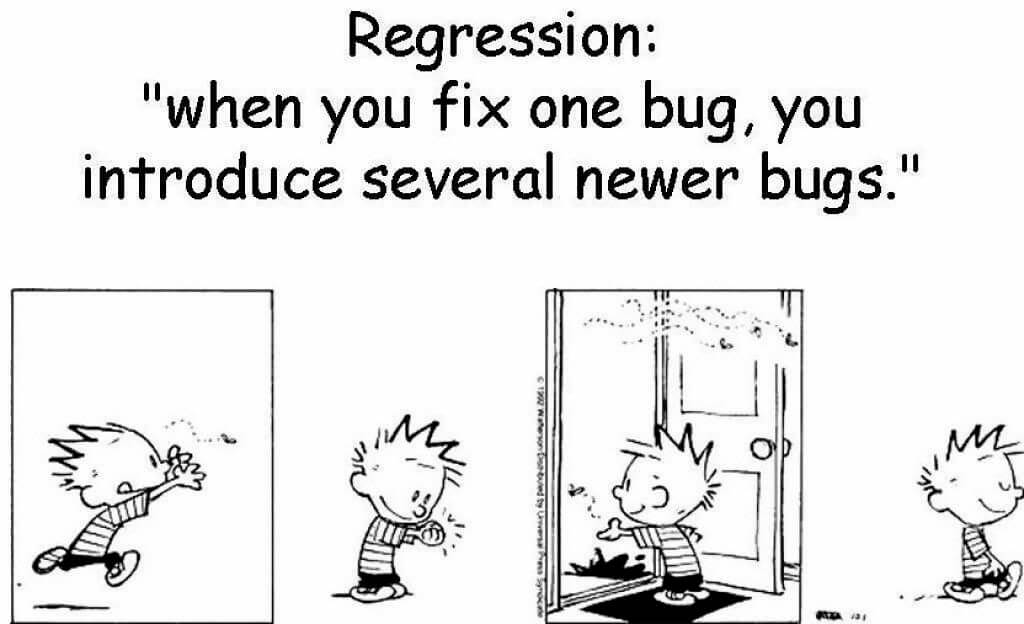
Hence, the regression testing meaning denotes an inclusive testing methodology that helps to reveal regression in software. More specifically, the procedure regression testing helps QA experts identify and rectify any glitches that may arise after bug fixes, performance improvements, or feature upgrades in software prior to its release.
During regression testing, previous tests are re-performed to validate proper functioning of some or all of software features, including the ones were not changed. QA experts do this to ensure that new code does not negatively affect the old one in any way.
Types Of Regression Testing
As evident from the regression testing definition, the procedure cover a lot of ground when it comes to reviewing and testing software. Depending upon the changes made and expected results, developers conduct different of regression testing.
The ultimate goal behind every type is to ensure the released software works efficiently. Therefore, it is important to choose the right type of regression testing before planning the product release.
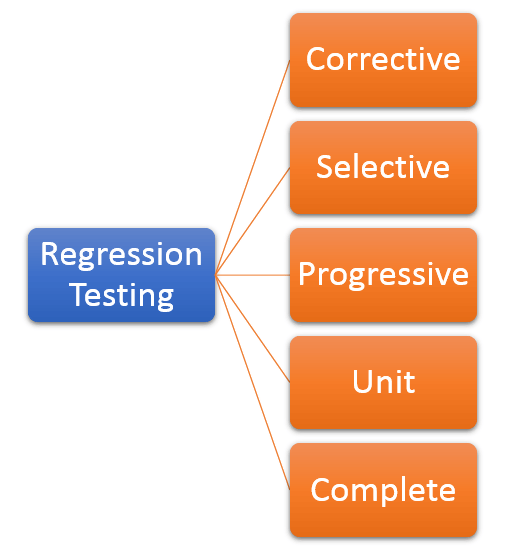
Different Types of Regression Testing
Let’s go through the types of regression testing.
1) Corrective Testing
Corrective testing is performed by reusing the existing test cases when no changes are made in the product.
2) Selective Testing
When new code is added, then selective testing is performed by using a subset of existing test cases. It is a cost-effective regression testing approach that requires fewer efforts from QA experts.
3)Progressive Testing
Progressive testing is performed when software gets an update. It helps to ensure that existing features are not affected or compromised by the update. To achieve that, QA experts create new test case scenarios.
4) Unit Testing
Unit testing is used to test a specific code unit separately by blocking all interactions and dependencies prior to testing.
5) Complete Testing
When software receives a major update to the existing code, then complete regression testing is required to validate its performance. This approach involves comprehensive retesting to spot any bugs that can arise as a result. Complete regression testing also ensures root code is not afffected.
Factors Different Regression Testing Strategies Rely On
Choosing the right regression testing strategy is key in achieving error-free software performance after an update, so you need to consider a number of factors in the process of creating yours:
- Nature of Product. To choose a fitting regression testing type, you need to consider the nature of your product first. A technique that works best to retest a website may not be suitable for testing a mobile application.
- Scale of Product. Your choice of the right software testing technique also depends on the complexity of your product. Small projects may only require one testing technique, while more complex software solutions may need multiple testing methods. Everything depends both on the scale of the product and changes made to it.
- Testing Method. Depending on the product, QA experts can choose either manual testing, automated testing, or both. While manual regression testing works best during the first phases of software development cycle, it is a time-consuming procedure that requires a lot of resources. Automated testing, on the other hand, simplifies the process, saving time and efforts. QA automation involves the use of dedicated QA tools (we will discuss them further).
- Testing Type. Based on the nature of changes and the product, the developers can choose either partial or complete regression testing for a product.
- Quality Testing Suite. Choosing a quality testing suite is also highly important. QA experts can use functional and non-functional test cases that cover all the features receiving updates in later stages of software development process.
Regression Testing Techniques
There are three software regression testing techniques. Still, more are emerging from them to cover the needs of different projects.
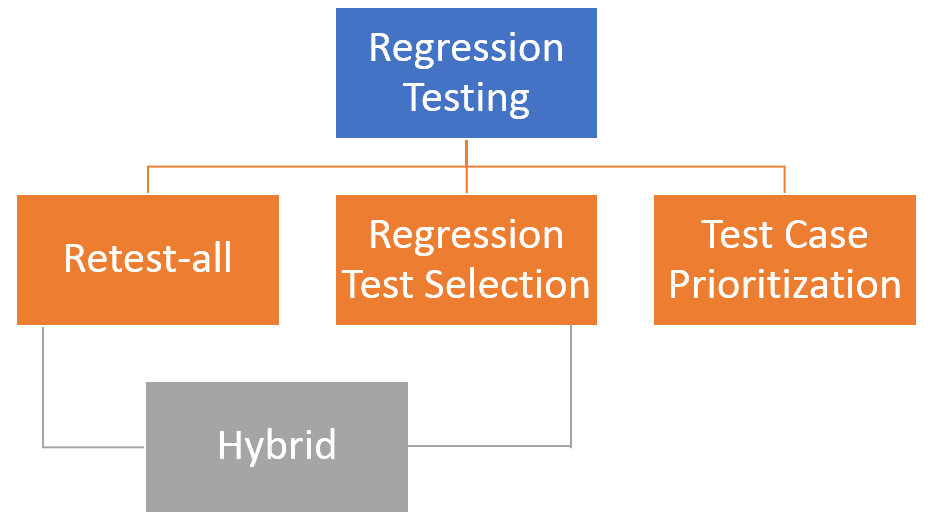
Regression Testing Techniques
1. Retest-all
This technique involves re-conducting all the test cases to ensure the absence of any bugs that may arise after changes to code have been made. Despite being useful, this technique demands more costs, time, and other resources.
2. Regression Test Selection
Based on changes to code, QA experts select only some test cases from the test suite instead of re-executing all cases.
This technique divides test cases into reusable (can be used in future regression testing cycles) and obsolete. Despite the name, obsolete test cases may sometimes prove useful in future versions of a product.
3. Test Case Prioritization
This technique prioritizes test cases for re-execution considering the importance of cases, their potential impact on the product, and the frequency of use.
Hybrid
Hybrid regression testing combines test selection and test case prioritization techniques. Here, the selected test cases from a test suite are prioritized for re-execution.
How To Do Regression Testing
Regardless of the technique you choose for regression testing, they all have the same process. Let’s explore it step-by-step.
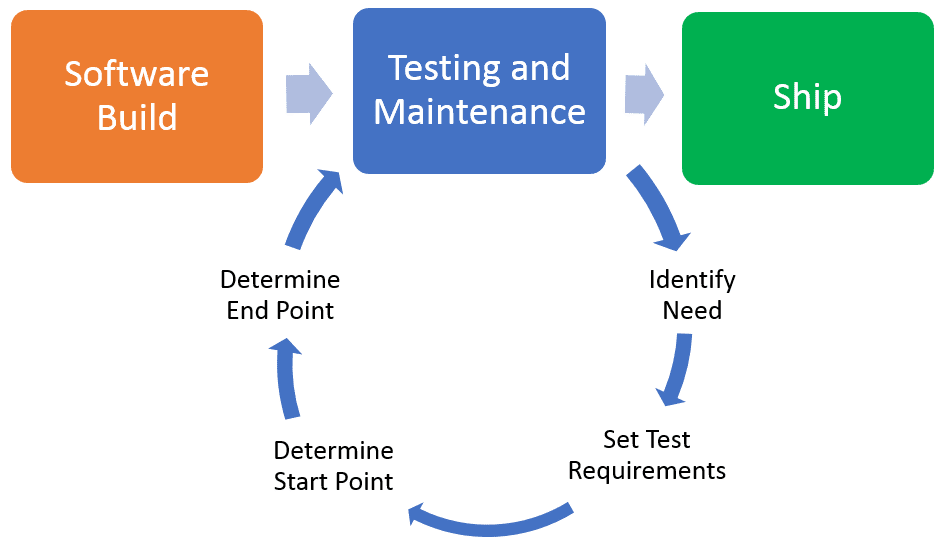
Performing Regression Testing
- Identify the need: After the software development phase is over, testing is carried out to address bug fixes, address performance issues, and other.
- Set test requirements: Based on the aim of testing and unit where it is required, QA experts create test conditions for regression testing.
- Determine the starting point: With requirements at hand, QA experts choose where to start testing.
- Determine endpoint: Planning is key, so QA experts also choose an endpoint for their testing efforts, which depends on requirements and the aim of their testing process.
Regression Testing Statistics on Software Changes
With every new change to the product and every new regression cycle, the number of test cases for future regression cycles changes (see the charts below). The testing process becomes more difficult, time-consuming, and costly. QA experts can deselect the test cases that no more remain useful to smooth out the execution of future regression cycles.
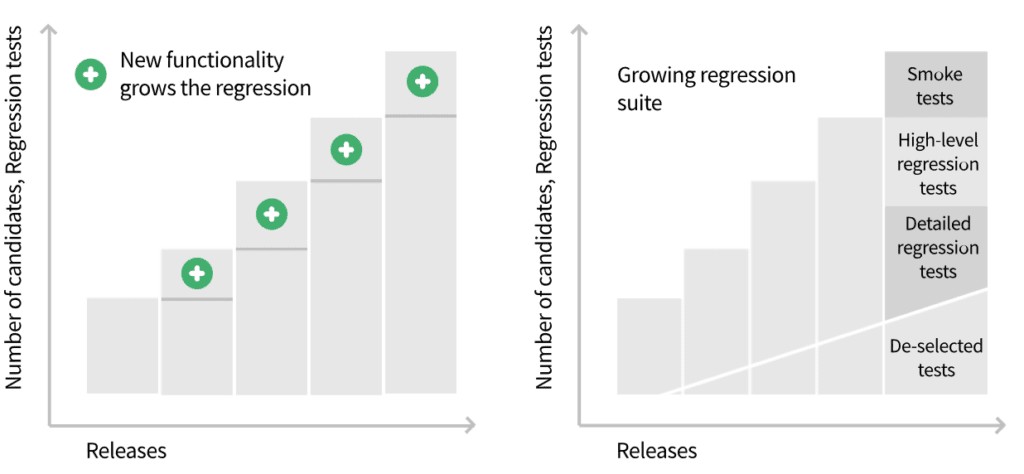
Source: Ranorex
Regression Testing Tools
Automated regression testing is a convenient alternative to manual testing, more so if software is updated frequently. With dedicated regression testing tools, automated testing has become much easier, quicker, and cost-effective.
Here are some of the most-used tools for automated software testing.
Ranorex Studio. A comprehensive automated testing tool for web, desktop, and mobile applications; offers built-in Selenium WebDriver and supports codeless automation with IDE plus tools.
Selenium. An open-source tool for browser-based regression tests; primarily aims at web apps automation.
Micro Focus UFT (Unified Functional Testing). Known as HP Quick Test Professional (QTP), the tool uses VBScript language to help automate functional and regression tests for software apps and environments.
IBM Rational Functional Tester (RFT). The tool provides functional, regression, data-driven, and GUI (Graphical User Interface) testing automation for various applications.
Other Regression Testing Software
- SahiPro
- TestDrive
- TimeShiftX
- Serenity
- Watir
- Test Complete
- AdventNet QEngine
- TestingWhiz
- Silktest
- QA Wizard Pro
Regression Testing Best Practices
If you are a QA engineer, it is highly important for you to comply with the best practices for regression testing. Here is a quick overview of what to consider in your testing process.
- Save time and resources by relying more on automation testing.
- As new test cases are added with each update, always keep the regression pack (a set of regression test cases) up-to-date.
- When you test, the main focus should be on software’s core functionality and the most popular features. Also, double-check if the test cases for these are in the regression pack and are up-to-date.
- Re-execute successful test cases, that is, the ones that previously spotted bugs successfully.
On top of that, it is better to create a dedicated policy for regression testing that accounts for product requirements and risk factors of a client’s business.
Regression Testing Examples
The process of regression testing is highly elaborate, but also very important. From minor bug fixes to feature upgrades and improvements, every successful software has QA specialists experienced in regression testing behind it.
Here is an example of regression testing:
https://www.youtube.com/watch?v=aeu5zacsHsI&feature=youtu.be
Difference Between Retesting And Regression Testing
Although the concepts of regression testing and retesting in software development may look similar on paper, they differ in practice.
Regression testing primarily refers to a testing procedure QA experts perform to detect bugs that may appear after code is changed. Regression testing ensures the changes do not affect existing functionality of software. Meanwhile, retesting is when QA experts re-execute tests after bug fixes to ensure the issue is removed.
Conclusion
Maintenance is the longest phase in the software development lifecycle. It starts after software is deployed and continues to the moment it is no more. For the most part, the success of this stage rests upon regression testing, as it ensures continuous and bug-free operation of software and successful updates to its existing functionality. Thanks to many automation tools for regression testing available, QA experts can perform easier, faster, and using less resources. Except that and the level of expertise of a QA expert, successful regression relies on a number of important guidelines, tried-and-true guidelines, and choosing a fitting automation tool for a given project.